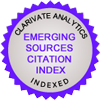Computer-aided Tooth Segmentation Using Image Processing Techniques and Convolutional Neural Network
İsmail Kayadibi1, Utku Köse2, Gür Emre Güraksın31Afyon Kocatepe University, Faculty of Economics and Administrative Sciences, Department of Management Information Systems, Afyonkarahisar, Turkey2Suleyman Demirel University, Faculty of Engineering, Department of Computer Engineering, Isparta, Turkey
3Afyon Kocatepe University, Faculty of Engineering, Department of Computer Engineering, Afyonkarahisar, Turkey
Panoramic dental radiography is a common imaging technique used to diagnose dental problems. However, the resolution of panoramic dental radiographs taken with this imaging method is relatively low. As a result, dental problems may be missed. Against this background, this study proposes a method involving image preprocessing techniques and a convolutional neural network (CNN) for tooth segmentation in computer-aided clinical decision support systems using panoramic dental radiographs. The performance of the proposed method is evaluated using the dataset of the Southwest Bahia State University (UESB). First, the U-Net, SegNet and DeepLabv3+ architectures are trained and then tested on the UESB dataset. Then, pre-processing methods such as Histogram Equalisation (HE), Contrast Stretching (CS), and Contrast Limited Adaptive Histogram Equalisation (CLAHE) are applied to the UESB dataset. To evaluate the impact of these pre-processing methods on the performance, the pre-processed datasets are retrained and tested on the U-Net, SegNet and DeepLabv3+ architectures. Based on the test results obtained, it is evident that CS is the preprocessing method that significantly improves the performance of the DeepLabv3+ and SegNet architectures compared to the other preprocessing methods used in this study. The best performance is achieved by the SegNet architecture trained on the CS preprocessed dataset and is subsequently proposed for tooth segmentation. The comparative performance analysis shows that CS has a performance-enhancing effect on both panoramic dental images and ESA architectures. Furthermore, the results obtained from the proposed method are compared with previous studies on the UESB dataset and this method is one of the methods that performs remarkably well compared to similar state-of-the-art methods in the literature. In conclusion, the proposed method can be used as a powerful tool in computer-aided decision support systems that can be developed for tooth segmentation.
Keywords: Tooth segmentation, deep learning, convolutional neural network, image processing, decision support systemsGörüntü İşleme Teknikleri ve Evrişimsel Sinir Ağı Kullanılarak Bilgisayar Destekli Diş Segmentasyonu
İsmail Kayadibi1, Utku Köse2, Gür Emre Güraksın31Afyon Kocatepe Üniversitesi, İktisadi ve İdari Bilimler Fakültesi, Yönetim Bilişim Sistemleri, Afyonkarahisar2Süleyman Demirel Üniversitesi, Mühendislik Fakültesi, Bilgisayar Mühendisliği, Isparta
3Afyon Kocatepe Üniversitesi, Mühendislik Fakültesi, Bilgisayar Mühendisliği, Afyonkarahisar
Panoramik diş röntgeni, diş problemlerinin teşhisi için kullanılan yaygın bir görüntüleme yöntemidir. Ancak, bu görüntüleme ile elde edilen panoramik diş röntgen görüntülerinin çözünürlüğü nispeten düşüktür. Bu nedenle, dişte oluşan problemler gözden kaçabilmektedir. Bu amaçla, bu çalışmada panoramik diş röntgen görüntülerinden bilgisayar destekli klinik karar destek sistemlerinde diş segmentasyonu için görüntü önişlem yöntemi ve evrişimsel sinir ağı (ESA) içeren bir yöntem önerilmiş ve bu önerilen yöntemin performans değerlendirmesi için Güneybatı Bahia Eyalet Üniversitesi (UESB) veri seti kullanılmıştır. İlk olarak, U-Net, SegNet ve DeepLabv3+ mimarileri UESB veri seti üzerinde eğitilmiş ve ardından test edilmiştir. Sonrasında, UESB veri setine sırasıyla Histogram Eşitleme (HE), Kontrast Germe (KG) ve Kontrast Sınırlı Uyarlanabilir Histogram Eşitleme (KSUHE) görüntü önişlemleri uygulanmıştır. Görüntü önişlem yöntemlerinin performansa etkisini ölçmek için, elde edilen önişlemli veri setleri U-Net, SegNet ve DeepLabv3+ mimarileri üzerinde tekrar eğitilmiş ve test edilmiştir. Elde edilen test sonuçlarına göre KG, bu çalışmada kullanılan diğer önişlemlere kıyasla DeepLabv3+ ve SegNet mimarilerinde en fazla performansı iyileştiren önişlem yöntemi olmuştur. En yüksek performansı ise, KG önişlemli veri seti ile eğitilmiş SegNet mimarisi elde etmiş ve diş segmentasyonu için önerilmiştir. Karşılaştırmalı performans analizinde KG hem panoramik diş görüntülerinin iyileştirilmesinde hem de ESA mimarileri üzerinde performans artırıcı yönde etkiye sahip olduğunu göstermiştir. Ayrıca, önerilen yöntemden elde edilen bulgular, UESB veri setinde yapılan önceki çalışmalarla karşılaştırılmış ve bu yöntem, literatürdeki benzer geliştirilen en son teknoloji yöntemlere göre kayda değer bir performans gösteren yöntemlerden birisi olmuştur. Sonuç olarak, önerilen yöntemin diş segmentasyonu için geliştirilecek bilgisayar destekli karar destek sistemlerinde güçlü bir araç olarak kullanılabileceği görülmüştür.
Anahtar Kelimeler: Diş segmentasyonu, derin öğrenme, evrişimsel sinir ağı, görüntü işleme, karar destek sistemleriCorresponding Author: İsmail Kayadibi, Türkiye
Manuscript Language: Turkish






